Evaluation of Nature-Based Solutions to Improve the Urban Microclimate in Mediterranean Climate Conditions: A Case Study of Izmir-Karsıyaka
Abstract
1. Introduction
2. Materials and Methods
2.1. Study Area
2.2. Introduction to ENVI-Met Model
2.3. Predicted Mean Vote (PMV) Analysis
2.4. Validation of ENVI-Met Software
3. Results and Discussion
3.1. Air Temperature
3.2. Predicted Mean Vote (PMV)
4. Conclusions
- At the urban micro scale, NBSs resulted in temperature changes of up to 2.5 °C in the research areas. Also, in terms of thermal comfort, the most significant differences were found between the minimum PMV values, close to 1 °C. In particular, the implementations of the nature-based solutions “URBAN GreenUP Project” (Scenario 2) were tested and proven to have a microclimate-improving effect. As suggested by this study and others, it is important to develop climate-sensitive policies and projects for cities, from physical planning to design. Taking into consideration climate-sensitive criteria in designs at all scales is crucial for creating more livable cities in terms of thermal comfort.
- The presence of green spaces alone is not sufficient to improve the microclimate; the size of green spaces is also very important. As observed in Scenario 1, the size of green areas greatly affects the quality and quantity of their contribution to climate. According to the analysis results, a temperature difference of 2.8 °C in the maximum temperature values in Sasalı Wildlife Park parking lot was calculated (Scenario 1), which included the largest green area. Green areas should be designed with the largest possible size, contain large permeable surfaces, and be composed of deciduous trees with large crowns. The existence of an urban green infrastructure system is necessary for the realization of all these factors.
- Deciduous trees were found to be more effective than palm trees in improving the urban climate (Scenario 1). In terms of other ecosystem services, it would be better not to preferentially use palm trees, especially in areas where shade is needed, but to use deciduous and wide-crowned species instead.
- As seen in Scenario 1, trees used continuously along the road on streets with a canyon effect, such as Girne Street, have a positive effect on improving the urban climate. According to the analysis results, a difference of 1.54 °C in the maximum temperature values in this area was calculated. This should be taken into consideration in street landscape designs. However, first of all, it is necessary to create the conditions and areas suitable for plant growth in street and alley designs. In these conditions, plants and especially trees that will reach their ideal form will be able to show the maximum desired effect.
- As a result of random urbanization, impervious surfaces such as parking lots occupy a significant area in cities. If they are treeless, as in the current situation of the Sasalı Wildlife Park parking lot, they significantly increase the ambient temperatures. Although Sasalı Wildlife Park is located in an area more rural than other areas, according to the current situation measurement results, it is 2.24 °C warmer than Girne Street and 0.9 °C warmer than the Vilayetler Evi parking lot in terms of the minimum temperature values. In areas consisting of large impervious surfaces such as parking lots, as in Scenario 3, trees with wide crowns should be preferred as permeable surfaces and shading elements to reduce heat stress. In addition, a design approach that combines appropriate sustainable rainwater facilities will provide an advantage in the fight against the heat island.
- According to the results of the research, it is clearly understood that, in this study conducted in Mediterranean climate conditions, especially in NBS scenarios, deciduous trees with large crowns have the most positive effect on reducing urban temperatures and improving thermal comfort conditions in all research zones. In Turkey, with different climate types, future studies should be conducted in different climatic conditions. Recommendations should be developed while taking into consideration the requirements of each specific climate type.
Author Contributions
Funding
Institutional Review Board Statement
Informed Consent Statement
Data Availability Statement
Conflicts of Interest
References
- United Nations. Global Perspective Human Stories. 2023. Available online: https://news.un.org/en/story/2021/09/1098662 (accessed on 12 January 2023).
- Shafaghat, A.; Manteghi, G.; Keyvanfar, A.; Bin Lamit, H.; Saito, K.; Ossen, D.R. Street Geometry Factors Influence Urban Microclimate in Tropical Coastal Cities: A Review. Environ. Clim. Technol. 2016, 17, 61–75. [Google Scholar] [CrossRef]
- Li, X.; Stringer, L.C.; Chapman, S.; Dallimer, M. How urbanization alters the intensity of the urban heat island in a tropical African city. PLoS ONE 2021, 16, e0254371. [Google Scholar] [CrossRef]
- Oliveira, A.; Lopes, A.; Correia, E.; Niza, S.; Soares, A. An urban climate-based empirical model to predict present and future patterns of the Urban Thermal Signal. Sci. Total. Environ. 2021, 790, 147710. [Google Scholar] [CrossRef]
- Goodess, C.; Berk, S.; Ratna, S.B.; Brousse, O.; Davies, M.; Heaviside, C.; Moore, G.; Pineo, H. Climate Change Projections for Sustainable and healthy Cities. Build. Cities 2021, 2, 812–836. [Google Scholar] [CrossRef]
- Reis, C.; Lopes, A.; Nouri, A.S. Urban heat island data by local weather types in Lisbon metropolitan area based on Copernicus climate variables dataset for European cities. Data Brief 2022, 42, 108292. [Google Scholar] [CrossRef]
- Chaturvedi, S.; Cheong, T.S.; Luo, Y.; Singh, C.; Shaw, R. IPCC Sixth Assessment Report (AR6): Climate Change 2022-Impacts, Adaptation and Vulnerability: Regional Factsheet Asia; IPCC: Geneva, Switzerland, 2022. [Google Scholar]
- Potchter, O.; Cohen, P.; Bitan, A. Climatic behavior of various urban parks during hot and humid summer in the Mediterranean city of Tel Aviv, Israel. Int. J. Clim. 2006, 26, 1695–1711. [Google Scholar] [CrossRef]
- Mirzaei, N.F.; Fadzil, S.F.S.; Taib, N.B.; Abdullah, A. Micro-Scale Evaluation of the Relationship between Road Surface and Air Temperature with Respect to Various Surrounding Greenery Covers. Res. J. Appl. Sci. Eng. Technol. 2015, 11, 454–459. [Google Scholar] [CrossRef]
- Zhang, S.; Li, S.; Shu, L.; Xiao, T.; Shui, T. Landscape Configuration Effects on Outdoor Thermal Comfort across Campus—A Case Study. Atmosphere 2023, 14, 270. [Google Scholar] [CrossRef]
- Li, G.; Zhang, X.; Mirzaei, P.A.; Zhang, J.; Zhao, Z. Urban heat island effect of a typical valley city in China: Responds to the global warming. Sustain. Cities Soc. 2018, 38, 736–745. [Google Scholar] [CrossRef]
- Nasrollahi, N.; Ghosouri, A.; Khodakarami, J.; Taleghani, M. Heat-Mitigation Strategies to Improve Pedestrian Thermal Comfort in Urban Environments: A Review. Sustainability 2020, 12, 10000. [Google Scholar] [CrossRef]
- Antoniadis, D.; Katsoulas, N.; Papanastasiou, D. Thermal Environment of Urban Schoolyards: Current and Future Design with Respect to Children’s Thermal Comfort. Atmosphere 2020, 11, 1144. [Google Scholar] [CrossRef]
- Martinelli, L.; Lin, T.-P.; Matzarakis, A. Assessment of the influence of daily shadings pattern on human thermal comfort and attendance in Rome during summer period. Build. Environ. 2015, 92, 30–38. [Google Scholar] [CrossRef]
- Shashua-Bar, L.; Tsiros, I.X.; Hoffman, M. Passive cooling design options to ameliorate thermal comfort in urban streets of a Mediterranean climate (Athens) under hot summer conditions. Build. Environ. 2012, 57, 110–119. [Google Scholar] [CrossRef]
- Lobaccaro, G.; Acero, J.A. Comparative Analysis of Green Actions to Improve Outdoor Thermal Comfort Inside Typical Urban Street Canyons. Urban Clim. 2015, 14, 251–267. [Google Scholar] [CrossRef]
- Gorodkov, A.V. Architecture, Design and Organization of Cultural Landscapes; Science Prospectus Publishing House: St. Petersburg, Russia, 2018; 416p, ISBN 978-5-903090-90-7. [Google Scholar]
- Baldinelli, G.; Bonafoni, S.; Anniballe, R.; Presciutti, A.; Gioli, B.; Magliulo, V. Spaceborne detection of roof and impervious surface albedo: Potentialities and comparison with airborne thermography measurements. Sol. Energy 2015, 113, 281–294. [Google Scholar] [CrossRef]
- European Commission. Towards an EU Research and Innovation Policy Agenda for Nature-Based Solutions & Re-Naturing Cities; Final Report of the Horizon 2020 Expert Group on “Nature-Based Solutions and Re-Naturing Cities; European Commission: Brussels, Belgium, 2015; ISBN 9789279460517.
- Toxopeus, H.; Kotsila, P.; Conde, M.; Katona, A.; van der Jagt, A.P.; Polzin, F. How ‘Just’ is Hybrid Governance of Urban Nature-Based Solutions? Cities 2020, 105, 102839. [Google Scholar] [CrossRef]
- Kabisch, N.; Frantzeskaki, N.; Pauleit, S.; Naumann, S.; Davis, M.; Artmann, M.; Haase, D.; Knapp, S.; Korn, H.; Stadler, J.; et al. Nature-Based Solutions to Climate Change Mitigation and Adaptation in Urban Areas: Perspectives on Indicators, Knowledge Gaps, Barriers, and Opportunities for Action. Ecol. Soc. 2016, 21, 39. [Google Scholar] [CrossRef]
- Urban GreenUP D4.1 Report on the Diagnosis of İzmir. Available online: https://www.urbangreenup.eu/cities/front-runners/izmir.kl (accessed on 22 October 2022).
- Ambrosini, D.; Galli, G.; Mancini, B.; Nardi, I.; Sfarra, S. Evaluating Mitigation Effects of Urban Heat Islands in a Historical Small Center with the ENVI-Met Climate Model. Sustainability 2014, 6, 7013–7029. [Google Scholar] [CrossRef]
- Tsitoura, M.; Tsoutsos, T.; Daras, T. Evaluation of comfort conditions in urban open spaces. Application in the island of Crete. Energy Convers. Manag. 2014, 86, 250–258. [Google Scholar] [CrossRef]
- Sayad, B.; Alkama, D.; Ahmad, H.; Baili, J.; Aljahdaly, N.H.; Menni, Y. Nature-based solutions to improve the summer thermal comfort outdoors. Case Stud. Therm. Eng. 2021, 28, 101399. [Google Scholar] [CrossRef]
- Mosca, F.; Sani, G.M.D.; Giachetta, A.; Perini, K. Nature-Based Solutions: Thermal Comfort Improvement and Psychological Wellbeing, a Case Study in Genoa, Italy. Sustainability 2021, 13, 11638. [Google Scholar] [CrossRef]
- Majidi, A.N.; Vojinovic, Z.; Alves, A.; Weesakul, S.; Sanchez, A.; Boogaard, F.; Kluck, J. Planning Nature-Based Solutions for Urban Flood Reduction and Thermal Comfort Enhancement. Sustainability 2019, 11, 6361. [Google Scholar] [CrossRef]
- Gómez, G.; Frutos, B.; Alonso, C.; Martín-Consuegra, F.; Oteiza, I.; De Frutos, F.; Castellote, M.M.; Muñoz, J.; Torre, S.; Fermoso, J.; et al. Selection of nature-based solutions to improve comfort in schools during heat waves. Int. J. Energy Prod. Manag. 2021, 6, 157–169. [Google Scholar] [CrossRef]
- European Commission. Urban GreenUP D4.3: Technical specifications of Izmir demo. Available online: https://ec.europa.eu/research/participants/documents/downloadPublic?documentIds=080166e5c4dd930b&appId=PPGMS (accessed on 18 March 2024).
- Kaçmaz, G. Nature-Based Solutions to Combat Climate Change. Landscape 2021, 3, 82–92. [Google Scholar] [CrossRef]
- Adigüzel, G.; Küçükerbaş, E.V. Kentsel Yeşil Alanlarin Mikro-Iklimsel Etkilerinin Izmir-Bornova örneğinde araştirilmasi. Ege Üniversitesi Ziraat Fakültesi Derg. 2018, 55, 255–263. [Google Scholar] [CrossRef][Green Version]
- Envi-Met, 2023. Envi-Met Software. Available online: http://www.envi-met.com (accessed on 21 February 2022).
- Liu, D.; Hu, S.; Liu, J. Contrasting the performance capabilities of urban radiation field between three microclimate simulation tools. Build. Environ. 2020, 175, 106789. [Google Scholar] [CrossRef]
- Aldakheelallah, A.A. A Study to Evaluate Urban Heat Mitigation Design Strategies to Improve Pedestrian’s Thermal Perception in Existing Canyons of Extreme Hot-Arid Cities. The Case of Phoenix, A Master of Science, Phoenix. Ph.D. Thesis, Delft University of Technology, Delft, The Netherlands, 2020; 147p. [Google Scholar]
- HOBO RX3000—Outdoor Remote Monitoring Station. Available online: https://www.hobodataloggers.com.au/rx3000 (accessed on 15 March 2022).
- Birim, N.G.; Turhan, C.; Atalay, A.S.; Akkurt, G.G. The Influence of Meteorological Parameters on PM10: A Statistical Analysis of an Urban and Rural Environment in Izmir/Türkiye. Atmosphere 2023, 14, 421. [Google Scholar] [CrossRef]
- Fanger, P.O. Thermal Comfort, Analysis and Applications in Environmental Engineering; McGraw-Hill Book Company: New York, NY, USA, 1972; 224p. [Google Scholar]
- Gagge, A.P.; Stolwijk, J.A.J.; Nishi, Y. An effective temperature scale based on a simple model of human physiological regulatiry response. Mem. Fac. Eng. 1972, 13, 21–36. [Google Scholar]
- Höppe, P. The physiological equivalent temperature—A universal index for the biometeorological assessment of the thermal environment. Int. J. Biometeorol. 1999, 43, 71–75. [Google Scholar] [CrossRef]
- Matzarakis, A.; Mayer, H.; Iziomon, M.G. Applications of a universal thermal index: Physiological equivalent temperature. Int. J. Biometeorol. 1999, 43, 76–84. [Google Scholar] [CrossRef]
- Lam, C.K.C.; Lee, H.; Yang, S.R.; Park, S. A review on the significance and perspective of the numerical simulations of out-door thermal environment. Sustain. Cities Soc. 2021, 71, 102971. [Google Scholar] [CrossRef]
- Willmott, C.J. On the validation of models. Phys. Geogr. 1981, 2, 184–194. [Google Scholar] [CrossRef]
- Mochida, A.; Lun, I.Y. Prediction of wind environment and thermal comfort at pedestrian level in urban area. J. Wind. Eng. Ind. Aerodyn. 2008, 96, 1498–1527. [Google Scholar] [CrossRef]
- Park, M.; Hagishima, A.; Tanimoto, J.; Narita, K.-I. Effect of urban vegetation on outdoor thermal environment: Field measurement at a scale model site. Build. Environ. 2012, 56, 38–46. [Google Scholar] [CrossRef]
- Qaid, A.; Ossen, D.R. Effect of asymmetrical street aspect ratios on microclimates in hot, humid regions. Int. J. Biometeorol. 2014, 59, 657–677. [Google Scholar] [CrossRef] [PubMed]
- Chatzinikolaou, E.; Chalkias, C.; Dimopoulou, E. Urban microclimate improvement using envi-met climate model. ISPRS–Int. Arch. Photogramm. Remote. Sens. Spat. Inf. Sci. 2018, XLII-4, 69–76. [Google Scholar] [CrossRef]
- Piselli, C.; Castaldo, V.; Pigliautile, I.; Pisello, A.; Cotana, F. Outdoor comfort conditions in urban areas: On citizens’ perspective about microclimate mitigation of urban transit areas. Sustain. Cities Soc. 2018, 39, 16–36. [Google Scholar] [CrossRef]
- Morakinyo, T.E.; Lai, A.; Lau, K.K.-L.; Ng, E. Thermal benefits of vertical greening in a high-density city: Case study of Hong Kong. Urban For. Urban Green. 2017, 37, 42–55. [Google Scholar] [CrossRef]
- Hanafi, A.; Alkama, D. Role of the urban vegetal in improving the thermal comfort of a public place of a contemporary Saharan city. Energy Procedia 2017, 119, 139–152. [Google Scholar] [CrossRef]
- Kong, L.; Lau, K.K.-L.; Yuan, C.; Chen, Y.; Xu, Y.; Ren, C.; Ng, E. Regulation of outdoor thermal comfort by trees in Hong Kong. Sustain. Cities Soc. 2017, 31, 12–25. [Google Scholar] [CrossRef]
- Huang, Q.; Meng, X.; Yang, X.; Jin, L.; Liu, X.; Hu, W. The ecological city: Considering outdoor thermal environment. Energy Procedia 2016, 104, 177–182. [Google Scholar] [CrossRef]
- Mohajerani, A.; Bakaric, J.; Jeffrey-Bailey, T. The urban heat island effect, its causes, and mitigation, with reference to the thermal properties of asphalt concrete. J. Environ. Manag. 2017, 197, 522–538. [Google Scholar] [CrossRef]
- Makhelouf, A. The effect of green spaces on urban climate and pollution. J. Environ. Health Sci. Eng. 2008, 1, 35–40. [Google Scholar]
- Vartholomaios, A. A parametric sensitivity analysis of the influence of urban form on domestic energy consumption for heating and cooling in a Mediterranean city. Sustain. Cities Soc. 2017, 28, 135–145. [Google Scholar] [CrossRef]
- Girgis, N.; Elariane, S.; Elrazik, M.A. Evaluation of heat exhausts impacts on pedestrian thermal comfort. Sustain. Cities Soc. 2016, 27, 152–159. [Google Scholar] [CrossRef]
- Taleghani, M.; Kleerekoper, L.; Tenpierik, M.; van den Dobbelsteen, A. Outdoor thermal comfort within five different urban forms in the Netherlands. Build. Environ. 2015, 83, 65–78. [Google Scholar] [CrossRef]
- Manteghi, G.; Lamit, H.; Ossen, D.R.; Aflaki, A. Envi- met simulation on cooling effect of Melaka River. Int. J. Energy Environ. Res. 2016, 4, 7–15. [Google Scholar]
- Karimi, A.; Sanaieian, H.; Farhadi, H.; Norouzian-Maleki, S. Evaluation of the thermal indices and thermal comfort improvement by different vegetation species and materials in a medium-sized urban park. Energy Rep. 2020, 6, 1670–1684. [Google Scholar] [CrossRef]
- Nasibeh, F.M. Effects of Road Geometry and Roadside Trees on Urban Road Thermal Performance in Penang. Ph.D. Thesis, Universiti Sains Malaysia, Penang, Malaysia, 2016. [Google Scholar]
- Narita, K.; Sugawara, H.; Honjo, T. Effects of roadside trees on the thermal environment within a street canyon. Geogr. Rep. Tokyo Metrop. Univ. 2008, 43, 41–48. [Google Scholar]
- Shahidan, M.F.; Jones, P.J.; Gwilliam, J.; Salleh, E. An evaluation of outdoor and building environment cooling achieved through combination modification of trees with ground materials. Build. Environ. 2012, 58, 245–257. [Google Scholar] [CrossRef]
- Altunkasa, C. İklimle Dengeli Tasarımda Dış Mekan Iklim Haritalarının Kullanım Olanakları: Çukurova Üniversitesi Mimarlık Fakültesi Örneği. Master’s Thesis, Çukurova Üniversitesi Fen Bilimleri Enstitüsü Peyzaj Mimarlığı Anabilim Dalı, Yüksek Lisans Tezi, Adana, Türkiye, 2019; 207p. [Google Scholar]
- Chen, H.; Ooka, R.; Kato, S. Study on optimum design method for pleasant outdoor thermal environment using genetic algorithms (GA) and coupled simulation of convection, radiation and conduction. Build. Environ. 2008, 43, 18–30. [Google Scholar] [CrossRef]
- Cohen, P.; Potchter, O.; Matzarakis, A. Daily and seasonal climatic conditions of green urban open spaces in the Mediterranean climate and their impact on human comfort. Build. Environ. 2012, 51, 285–295. [Google Scholar] [CrossRef]
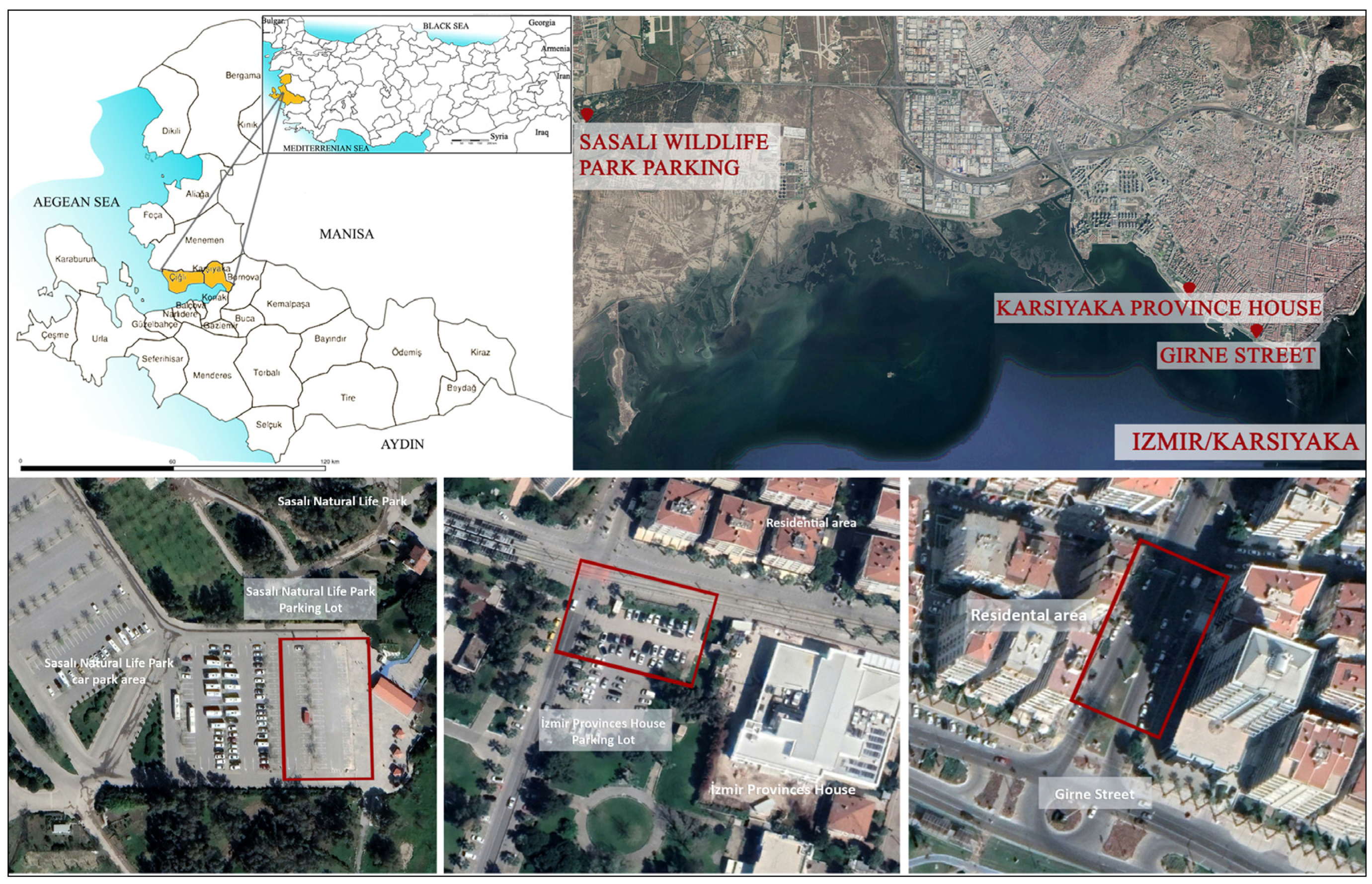
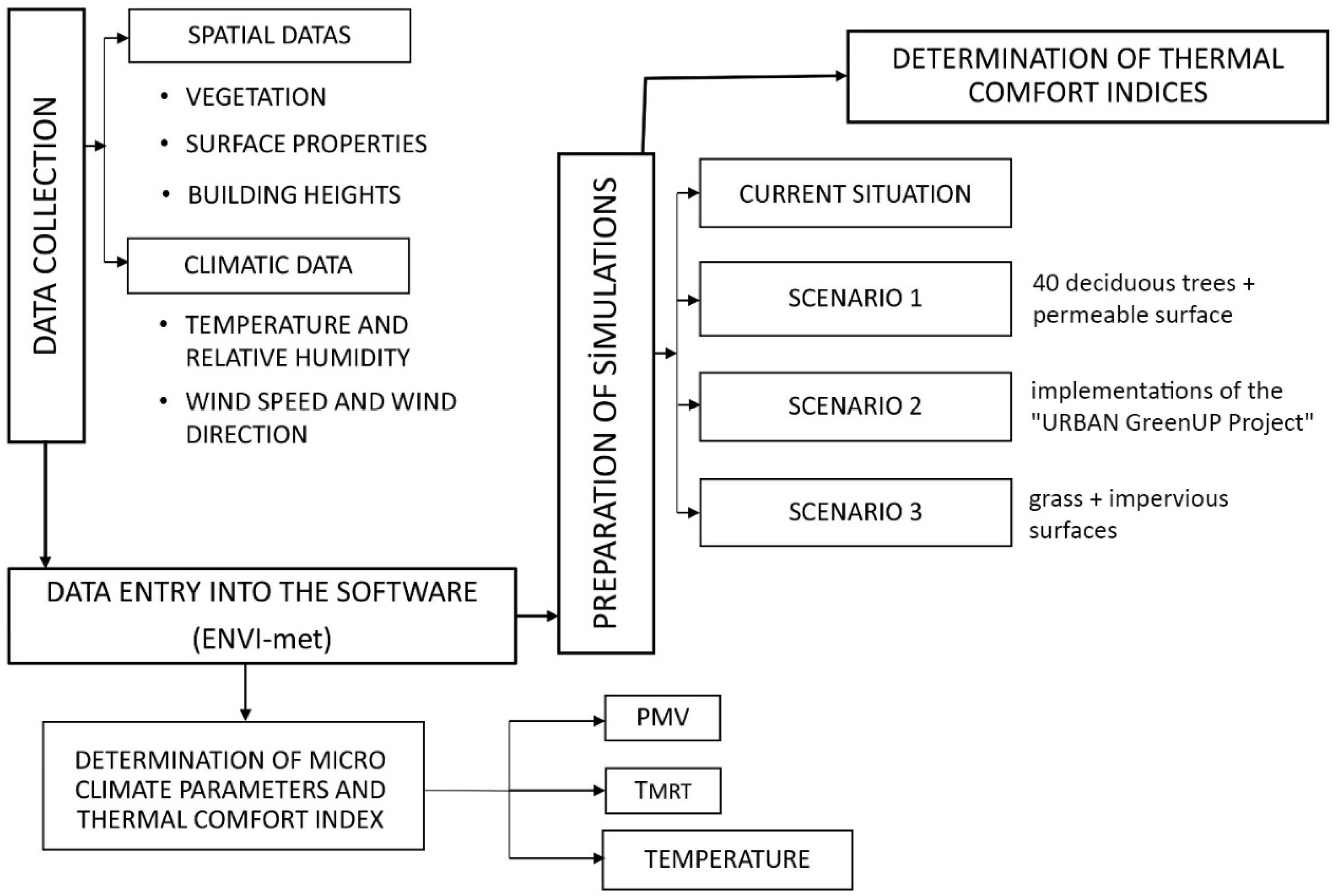
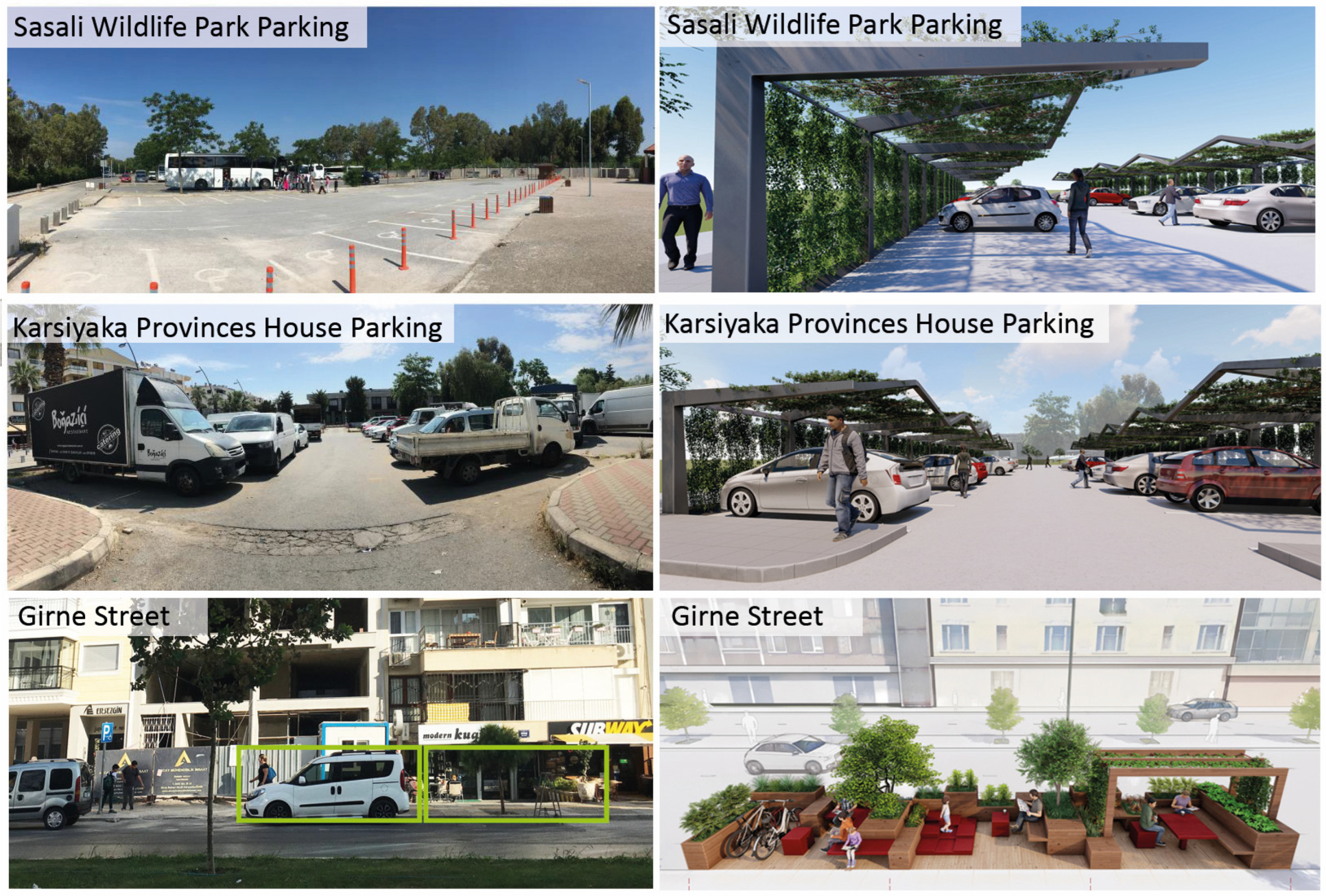

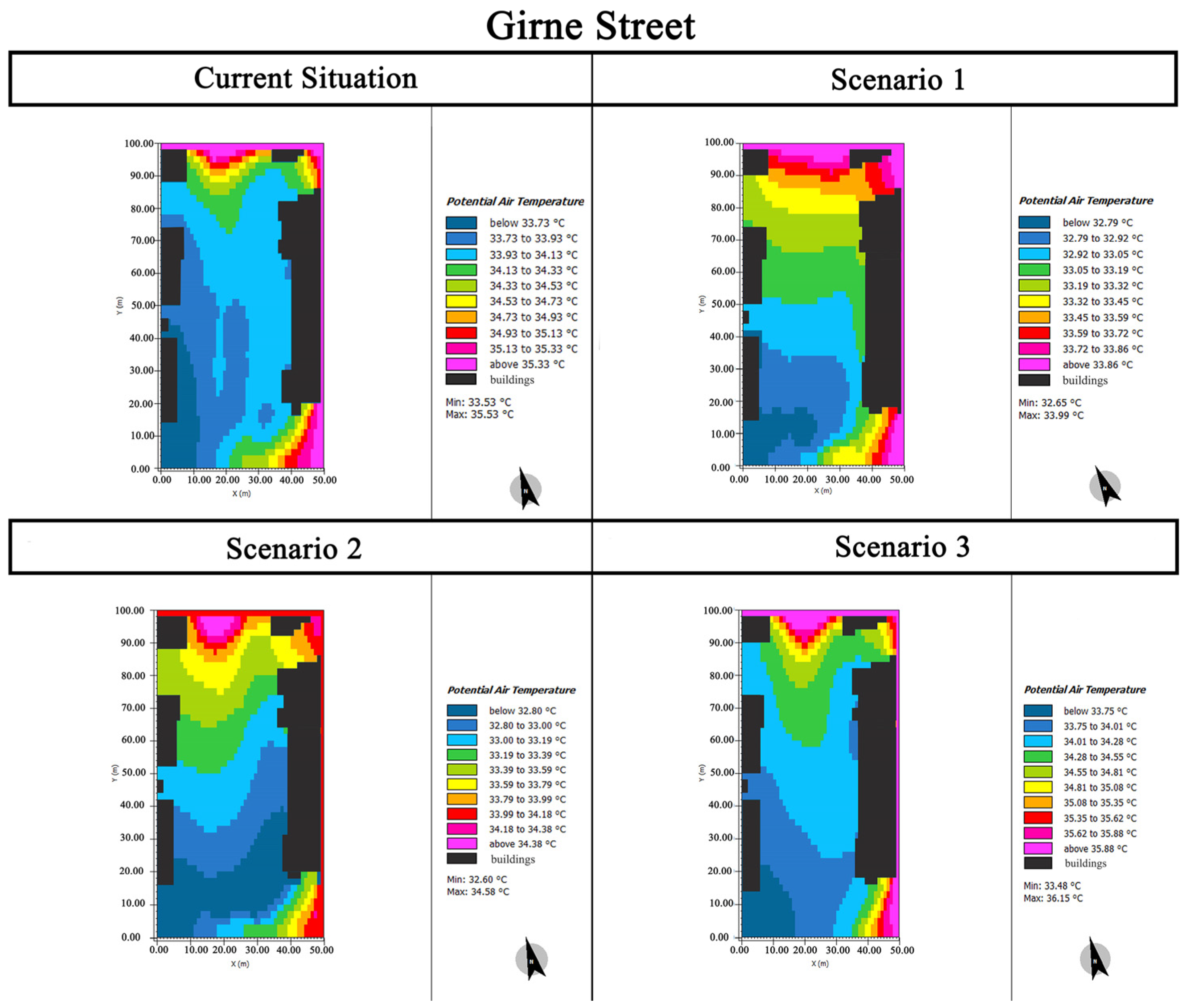
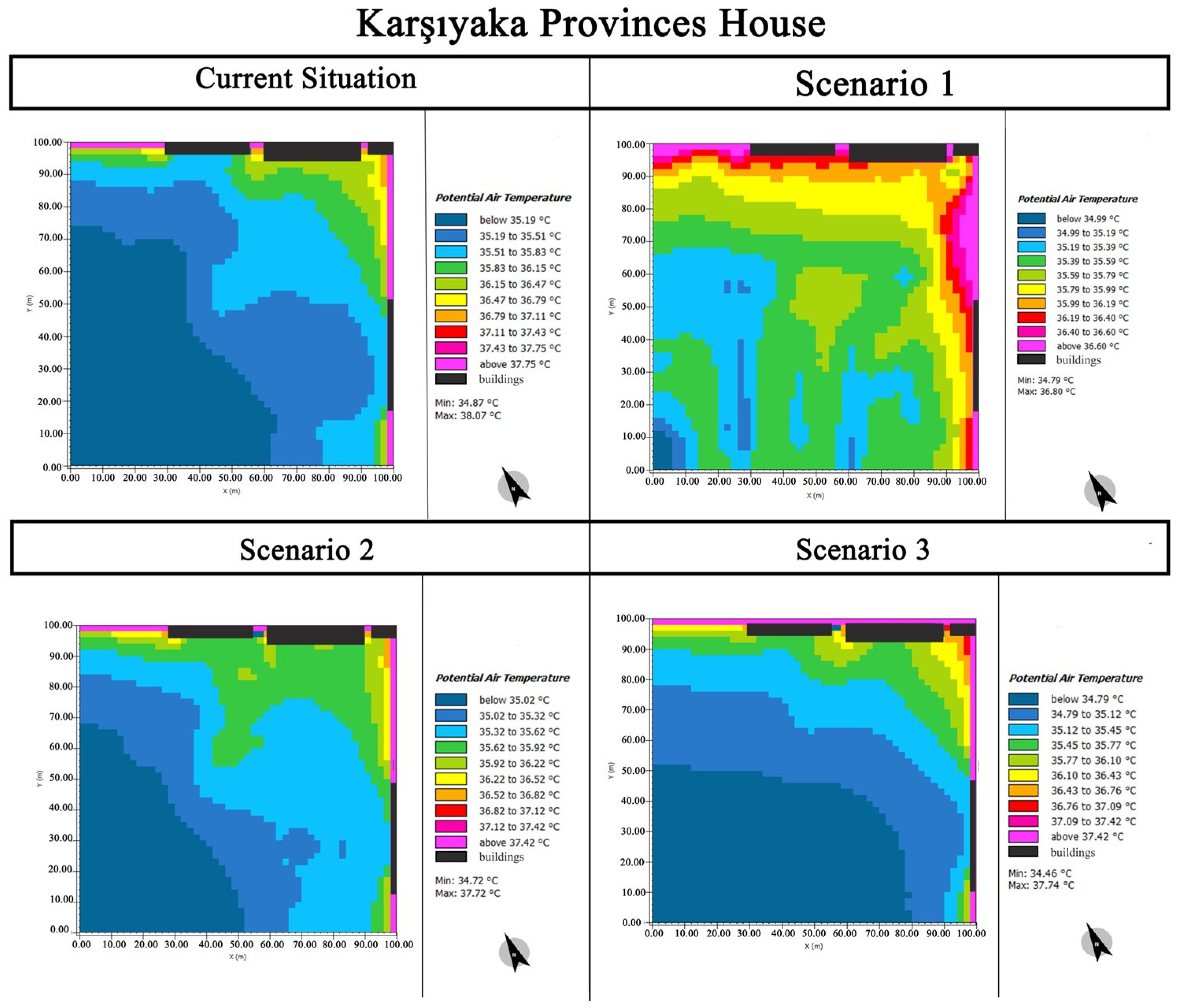
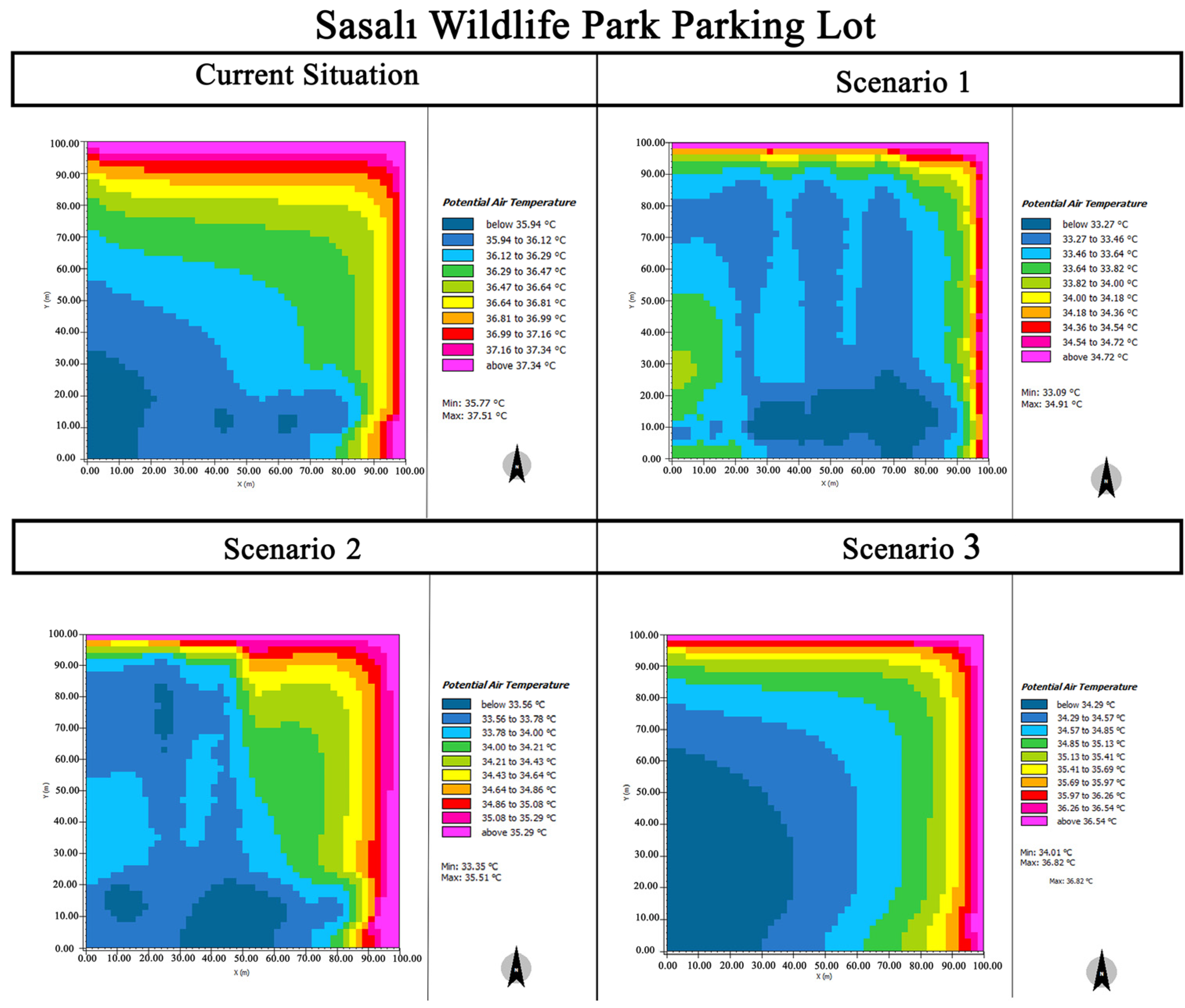
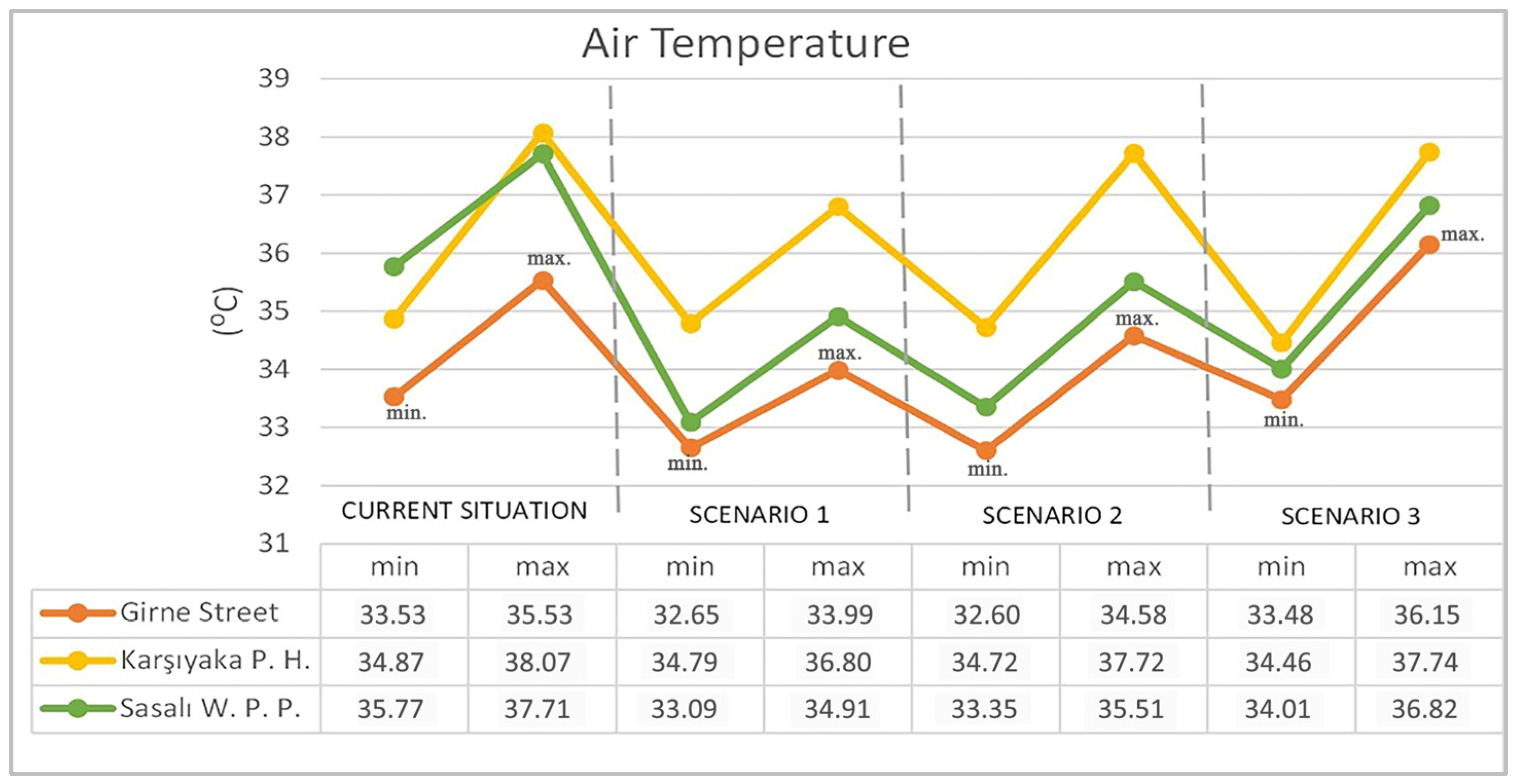


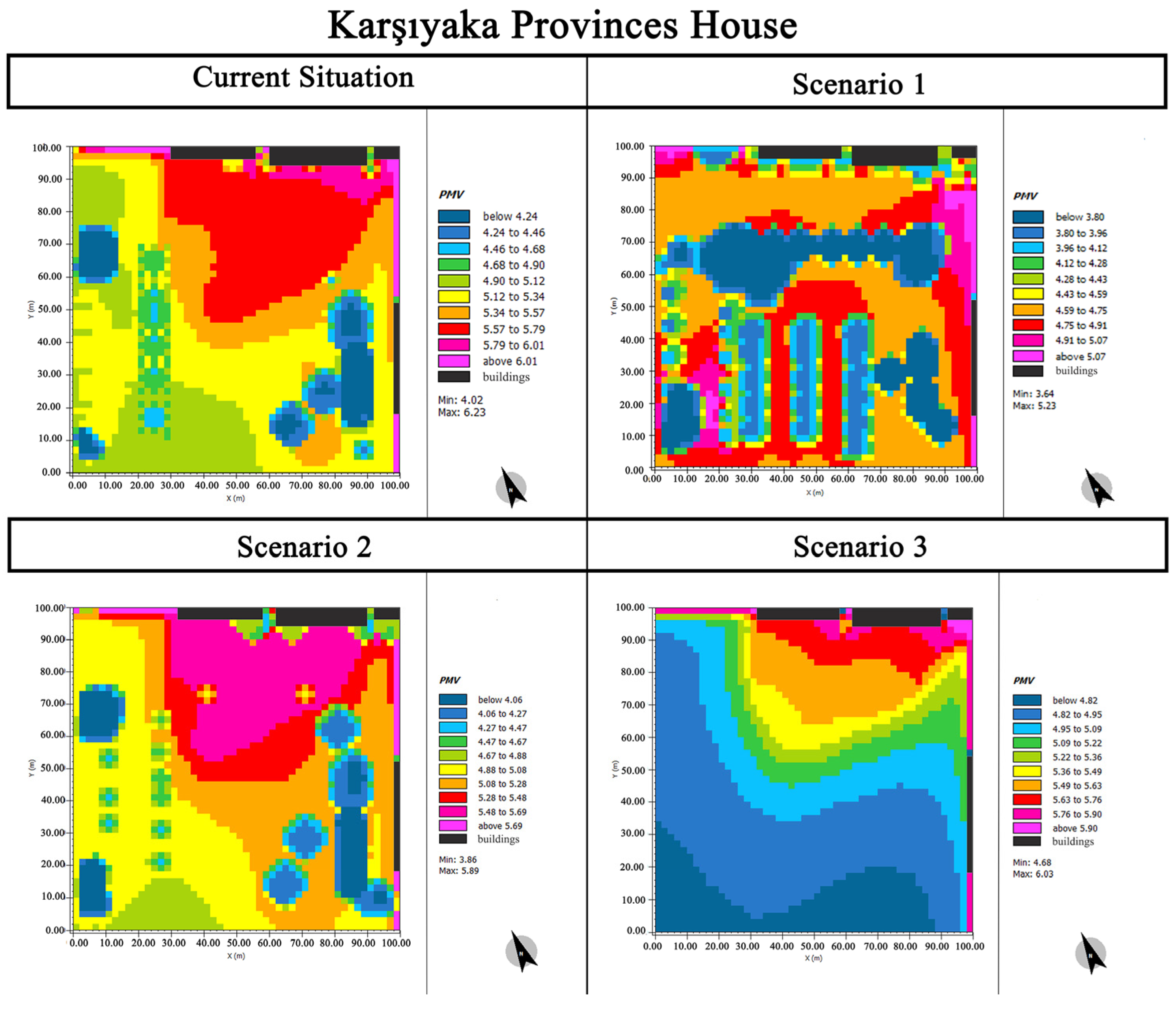
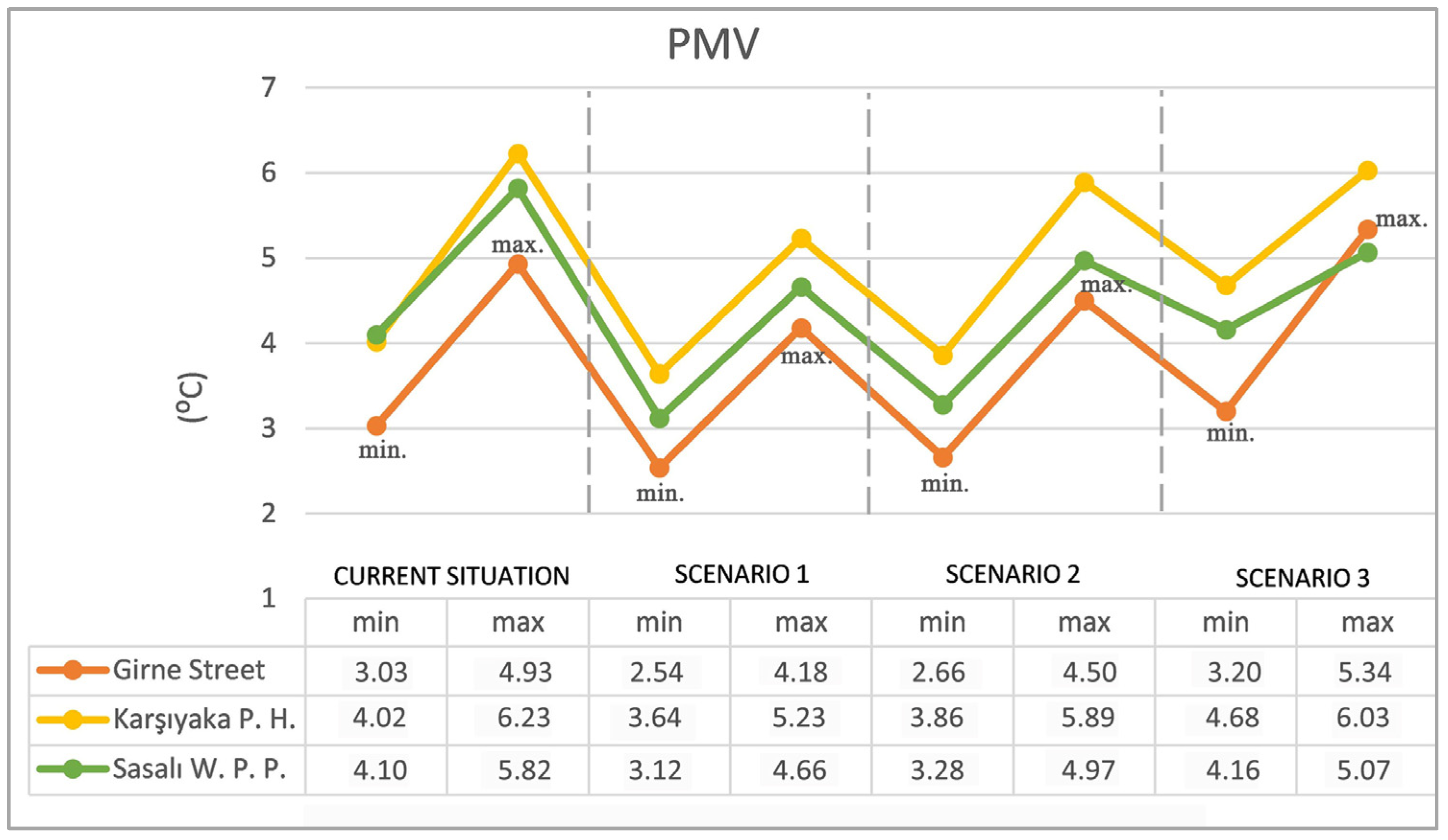
| Widths of the Buildings (m) | Paving Materials | Type of Nearby Settlement | Plant Material Present | |
|---|---|---|---|---|
| Girne Street | 15–35 | Granite | Residential and commercial | Platanus orientalis, Pinus pinea, Washingtonia filifera, and Cupressus macrocarpa |
| Karsıyaka Provinces House Parking Lot | 10–15 | Concrete paving | Residential and commercial | Ilex aquifolium, Robinia pseudoacacia, Schinus molle, and Washingtonia filifera |
| Sasalı Wildlife Park, Parking Lot | - | Concrete paving | Agricultural areas and woodland | Robinia pseudoacacia, grass |
| Specifications | WS | WD |
|---|---|---|
| Measurement Range | 0 to 76 m/s (0 to 170 mph) | 0 to 355 degrees, 5-degree dead band |
| Accuracy | ±1.1 m/s (2.4 mph) or ±4% of reading, whichever is greater | ±5 degrees |
| Resolution | 0.5 m/s (1.1 mph) | 1.4 degrees |
| Specifications | Tair | RH |
| Measurement Range | −40 to 70 °C | 0 to 100% RH, −40 °C to 70 °C |
| Accuracy | ±0.25 °C from −40 to 0 °C | ±2.5% from 10% to 90% (typical) to a maximum of ±3.5% including hysteresis at 25 °C; below 10% RH and above 90% RH ± 5% typical |
| Resolution | 0.02 °C | 0.01% |
| Location | Girne Street | |||
|---|---|---|---|---|
| Spatial data | Domain size (x, y, z) | 50 m × 50 m × 30 m | ||
| Spatial resolution (x, y, z) | 1 m × 2 m × 2 m | |||
| Model rotation | 15° | |||
| Roughness | 2 | |||
| Roadway/parking | Asphalt | |||
| Pedestrian paths | Granite | |||
| Vegetation (permeable surface) | Medium density grass | |||
| The plants used | Platanus orientalis, Pinus pinea, Washingtonia filifera, and Cupressus macrocarpa | |||
| .SIM data | Simulation period | 24–25 August 2020 | ||
| Simulation start time | 13.00 | |||
| Total simulation duration | 24 | |||
| Climate data | Wind speed (m/s) | 0.5 | ||
| Wind direction (0:N, 90:E, 180:S, 270:W) | 225° | |||
| Lowest in air temperature | Highest in air temperature | 33.62 °C | 39.49 °C | |
| Lowest inner humidity | Highest inner humidity | 34.30 °C | 71.97 °C | |
| Location | Karsiyaka Provinces House Parking | |||
|---|---|---|---|---|
| Spatial data | Domain size (x, y, z) | 50 m × 50 m × 30 m | ||
| Spatial resolution (x, y, z) | 2 m × 2 m × 2 m | |||
| Model rotation | 15° | |||
| Roughness | 2 | |||
| Roadway/parking | Asphalt | |||
| Pedestrian paths | Concrete paving | |||
| Vegetation (permeable surface) | Medium density grass | |||
| The plants used | Ilex aquifolium, Robinia pseudoacacia, Schinus molle, and Washingtonia filifera | |||
| .SIM data | Simulation period | 24–25 August 2020 | ||
| Simulation start time | 13.00 | |||
| Total simulation duration | 24 | |||
| Climate data | Wind speed (m/s) | 0.5 | ||
| Wind direction (0:N, 90:E, 180:S, 270:W) | 225° | |||
| Lowest in air temperature | Highest in air temperature | 32.18 °C | 43.14 °C | |
| Lowest inner humidity | Highest inner humidity | 21.77 °C | 47.03 °C | |
| Location | Sasali Wildlife Park Parking | |||
|---|---|---|---|---|
| Spatial data | Domain size (x, y, z) | 50 m × 50 m × 30 m | ||
| Spatial resolution (x, y, z) | 2 m × 2 m × 1 m | |||
| Model rotation | 0 | |||
| Roughness | 1 | |||
| Roadway/parking | - | |||
| Pedestrian paths | Concrete paving | |||
| Vegetation (permeable surface) | Medium density grass | |||
| The plants used | Robinia pseudoacacia | |||
| .SIM data | Simulation period | 24–25 August 2020 | ||
| Simulation start time | 13.00 | |||
| Total simulation duration | 24 | |||
| Climate data | Wind speed (m/s) | 0.5 | ||
| Wind direction (0:N, 90:E, 180:S, 270:W) | 225° | |||
| Lowest in air temperature | Highest in air temperature | 34.44 °C | 39.49 °C | |
| Lowest inner humidity | Highest inner humidity | 28.79 °C | 71.97 °C | |
| PMV (°C) | Thermal Perception | Psychological Stress Level |
|---|---|---|
| −3.5 | Very cold | Extreme cold stress |
| −2.5 | Cold | Strong cold stress |
| −1.5 | Cool | Moderate cold stress |
| −0.5 | Slightly cool | Mild cold stress |
| 0.5 | Comfortable | No thermal stress |
| 1.5 | Slightly warm | Mild heat stress |
| 2.5 | Hot | Strong heat stress |
| +3.5 | Very hot | Extreme heat stress |
| Research Areas | Root Mean Squared Error (RMSE) | Agreement Index (d) |
|---|---|---|
| Girne Street | 1.68 | 0.952 |
| Karsıyaka Provinces House Parking Lot | 1.69 | 0.975 |
| Sasalı Wildlife Park Parking Lot | 0.96 | 0.974 |
| Current Situation | Scenario 1 | Scenario 2 | Scenario 3 | |||||
|---|---|---|---|---|---|---|---|---|
| Min | Max | Min | Max | Min | Max | Min | Max | |
| Girne Street | ||||||||
| Temperature (°C) | 33.53 | 35.53 | 32.65 | 33.99 | 32.60 | 34.58 | 33.48 | 36.15 |
| PMV (°C) | 3.03 | 4.93 | 2.54 | 4.18 | 2.66 | 4.50 | 3.20 | 5.34 |
| Karsıyaka Provinces House | ||||||||
| Temperature (°C) | 34.87 | 38.07 | 34.79 | 36.80 | 34.72 | 37.72 | 34.46 | 37.74 |
| PMV (°C) | 4.02 | 6.23 | 3.64 | 5.23 | 3.86 | 5.89 | 4.68 | 6.03 |
| Sasalı Wildlife Park Parking | ||||||||
| Temperature (°C) | 35.77 | 37.71 | 33.09 | 34.91 | 33.35 | 35.51 | 34.01 | 36.82 |
| PMV (°C) | 4.10 | 5.82 | 3.12 | 4.66 | 3.28 | 4.97 | 4.16 | 5.07 |
Disclaimer/Publisher’s Note: The statements, opinions and data contained in all publications are solely those of the individual author(s) and contributor(s) and not of MDPI and/or the editor(s). MDPI and/or the editor(s) disclaim responsibility for any injury to people or property resulting from any ideas, methods, instructions or products referred to in the content. |
© 2024 by the authors. Licensee MDPI, Basel, Switzerland. This article is an open access article distributed under the terms and conditions of the Creative Commons Attribution (CC BY) license (https://creativecommons.org/licenses/by/4.0/).
Share and Cite
Kaçmaz Akkurt, G.; Şemsiyeci, S. Evaluation of Nature-Based Solutions to Improve the Urban Microclimate in Mediterranean Climate Conditions: A Case Study of Izmir-Karsıyaka. Sustainability 2024, 16, 2646. https://doi.org/10.3390/su16072646
Kaçmaz Akkurt G, Şemsiyeci S. Evaluation of Nature-Based Solutions to Improve the Urban Microclimate in Mediterranean Climate Conditions: A Case Study of Izmir-Karsıyaka. Sustainability. 2024; 16(7):2646. https://doi.org/10.3390/su16072646
Chicago/Turabian StyleKaçmaz Akkurt, Gülşah, and Seda Şemsiyeci. 2024. "Evaluation of Nature-Based Solutions to Improve the Urban Microclimate in Mediterranean Climate Conditions: A Case Study of Izmir-Karsıyaka" Sustainability 16, no. 7: 2646. https://doi.org/10.3390/su16072646
APA StyleKaçmaz Akkurt, G., & Şemsiyeci, S. (2024). Evaluation of Nature-Based Solutions to Improve the Urban Microclimate in Mediterranean Climate Conditions: A Case Study of Izmir-Karsıyaka. Sustainability, 16(7), 2646. https://doi.org/10.3390/su16072646





